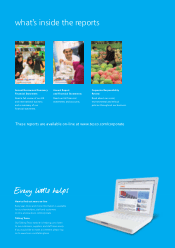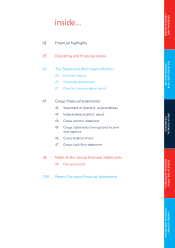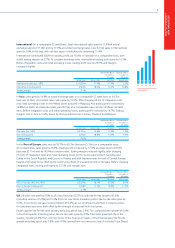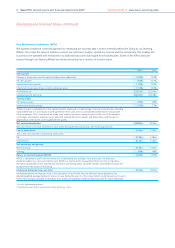Tesco 2007 Annual Report Download - page 9
Download and view the complete annual report
Please find page 9 of the 2007 Tesco annual report below. You can navigate through the pages in the report by either clicking on the pages listed below, or by using the keyword search tool below to find specific information within the annual report.
7
OPERATING AND
FINANCIAL REVIEW
Total Shareholder Return Total shareholder return (TSR),
which is measured as the percentage increase in the share
price, plus the dividend paid, has increased by 36% in
2006/07, its largest value increase for ten years – and the
fastest percentage growth rate for three years.
Over the last three years, TSR has grown 87% compared
with the FTSE100 average of 58%. Over five years, the
increase has been 102% compared to the increase in the
average for FTSE100 companies of just 50%.
Releasing value from property
As announced last April, we plan to release cash from property
through a sequence of joint ventures and other transactions,
both in the UK and internationally and return significant value
to shareholders, either through enhanced dividends (through
the growth in underlying earnings per share, which includes
property profits) or share buy-backs. The first of these deals,
with the British Airways Pension Fund, which formed part of
our plan to release some £5bn of funds from property over five
years, was completed during the second half. A second, larger
joint venture transaction was completed with The British Land
Company PLC after the year end.
Combined, these two transactions involved the divestment
to these joint ventures of some 5% of our UK store space.
They realised £1,015m in net proceeds and were completed at
very attractive initial yields below 4.5%, whilst also delivering
significant property profits from which dividends are paid to
shareholders. The average premium to bookvalue on these
transactions has been nearly 100%. Some of the proceeds
have already been used to fund our share buy-back
programme. Importantly, these joint ventures also provide
us with the right platform to run our business for customers.
The net book value of our fixed assets is £17bn – most of it
in freehold stores – even after these divestments. We estimate
current market value to be around 65% higher than this.
Given the store of value embedded in our property and the
strength of our covenant we have decided to divest more
freehold property assets than the £5bn we announced last
April. This is consistent with our commitment to retain the
strong asset-backing to our balance sheet and the freehold
element of our property base will be maintained above 70%.
At least £1.5bn of our originally planned £5bn of proceeds
were to be used to buyTesco shares in the market, initially to
offset future dilution to earnings per share and almost £470m
has already been spent in this way. In light of our enlarged
programme of property divestment, we now plan to return
a total of at least £3bn of the proceeds to shareholders.
Pensions The provision of Tesco’s award-winning UK defined
benefit pension scheme for our staff remains an important
priority. It goes to the heart of our values and helps us attract
and retain the best people. We manage and fund our scheme
on an actuarial valuation basis and, as at December 2006, the
scheme was estimated to be fully funded, largely as a result
of improved asset performance.
IFRS requires that we value pension scheme liabilities using a
high quality corporate bond yield and calculate the operating
charge in the Income Statement as if invested purely in bonds.
At February 2007, the IAS 19 pension deficit was just under
£670m on a post-tax basis, a significant reduction on last
year, reflecting Pensions A-Day. The A-Day change enabled
members of our UK defined benefit scheme to gain additional
pension flexibility, altering our pension scheme assumptions
and resulting in a reduction of the future liability by £250m
pre-tax (see pensions adjustment on page 6).






















